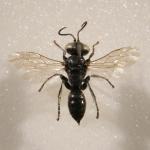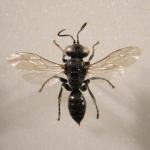This species has only recently been recognised in Britain, previously being confused under the name T. unicolor. Most records of the latter belong to the present species.
Both Tachysphex unicolor and T. nitidus are present in the British Isles. The separation of the two species has not been adequately documented in the English language, but is correct in Bitsch et al., 2001 Faune de France 86. Unless explicitly stated that this key has been used, or any subsequent one which recognises this situation, all records should be placed in agg.
North Devon to Kent (including the Dorset coast, but apparently not the Isle of Wight); the south Wales coast, and north to North Lincolnshire, Westmorland and the Isle of Man. In the Channel Islands, the species appears to be confined to Guernsey. Overseas it is found in northern and central Europe southwards to southern Spain, the Canary Islands and North Africa. The range extends eastwards to Syria and Israel.
The first map is records of T. nitidus agg and includes both T. unicolor and T. nitidus. The second map is for Tachysphex nitidus iso Bitsch et al., 2001
Not listed in Shirt (1987) or Falk ( 1991). Improved knowledge of its distribution suggests its status should be revised.
Sparsely vegetated sandy areas of coasts and heathland; compare with T. pompiliformis, which occupies more vegetated areas.
Univoltine; May to August.
Nymphs of grasshoppers (Acrididae).
Nesting takes place in sandy soils. Burrows are up to 30 cm long and constructed at a very acute angle to the ground, so that the single chamber is only about 3 cm be low ground level. The prey is flown or dragged to the nest, depending on its size (Lomholdt, 1975-76).
No information available.
Miltogrammine flies of the genus Taxigramma parasitise this wasp in Europe (Lomholdt, 1975-76). It is not known whether any flies have the same habit in Britain.
1998



